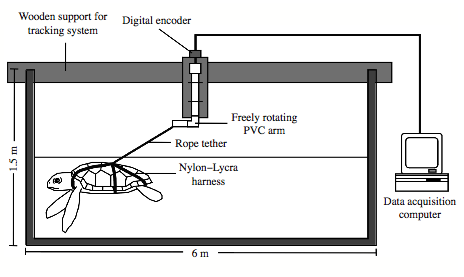Sea turtles use Earth’s magnetic fields to navigate by sensing the direction and intensity of the magnetic field. This ability helps them find their way during long migrations across the ocean.
Sea turtles, fascinating creatures of the sea, possess a unique and remarkable skill that allows them to navigate vast distances with precision. By utilizing Earth’s magnetic fields, these turtles can determine their location and course, aiding in their migration patterns and foraging habits.
The ability to sense the direction and intensity of the magnetic field enables sea turtles to navigate the open ocean, returning to their nesting grounds with astonishing accuracy. This natural navigation system has intrigued scientists for years, highlighting the extraordinary adaptations of these ancient marine reptiles. We delve deeper into how sea turtles utilize magnetic fields to guide their way through the vast ocean expanses.
Evolutionary Adaptations
Evolutionary adaptations have equipped sea turtles with remarkable abilities to navigate the vast oceans with precision and accuracy. One of the most intriguing adaptations is their utilization of magnetic fields for navigation. Understanding the evolutionary background and importance of magnetic field sensitivity in sea turtles’ navigation skills sheds light on their remarkable abilities.
Evolutionary Background Of Sea Turtles’ Navigation Skills
Sea turtles have been navigating the world’s oceans for millions of years, and their remarkable navigation skills have been a subject of fascination for scientists and researchers. The ability of sea turtles to sense and interpret the Earth’s magnetic field is an evolutionary marvel that has enabled them to undertake long migrations and return to the exact beaches where they were born.
Importance Of Magnetic Field Sensitivity In Evolution
The magnetic field sensitivity of sea turtles is critical for their survival and reproductive success. By harnessing the Earth’s magnetic fields, sea turtles can navigate the vast ocean expanses with astonishing accuracy, aiding in their foraging, mating, and nesting behaviors. This evolutionary adaptation has proven to be essential for the survival of sea turtle populations and underscores the significance of understanding and preserving their natural habitats.
Magnetic Field Detection
Magnetic field detection is a fascinating aspect of sea turtle navigation, and researchers have been intrigued by the biological mechanisms that enable these marine creatures to sense the Earth’s magnetic field. Through a combination of biological adaptations and the presence of magnetite in their bodies, sea turtles possess a unique ability to detect and utilize magnetic fields for navigation, allowing them to embark on incredible oceanic journeys with remarkable precision.
Biological Mechanisms Of Sensing Earth’s Magnetic Field
Sea turtles have an extraordinary ability to sense the Earth’s magnetic field, which is crucial for their long-distance migrations. The biological mechanisms behind this remarkable feat involve specialized cells in their brains that are sensitive to magnetic fields. These cells, known as magnetoreceptors, enable sea turtles to perceive the Earth’s magnetic field and use it as a navigational aid during their extensive travels across the oceans.
Role Of Magnetite In Sea Turtles’ Navigation
Magnetite, a naturally occurring magnetic mineral, plays a pivotal role in sea turtles’ navigation abilities. It is believed that sea turtles have magnetite particles embedded in their bodies, particularly in their brains and nervous systems. This presence of magnetite allows sea turtles to detect and interpret the Earth’s magnetic field, providing them with a reliable reference for orientation and navigation as they traverse vast distances in the ocean.
Navigational Strategies
Sea turtles have a remarkable ability to navigate using Earth’s magnetic fields. This natural navigational strategy helps them find their way during long migrations across the ocean. By sensing the Earth’s magnetic field, sea turtles can orient themselves and travel to specific locations with impressive accuracy.
Sea turtles are known for their remarkable navigational abilities. They travel long distances across the ocean, finding their way back to their original nesting sites to lay eggs. But how do they manage to navigate through the vast and featureless ocean? The answer lies in their ability to sense the earth’s magnetic field. In this article, we will explore the navigational strategies of sea turtles, focusing on their migration patterns and utilization of magnetic fields.Migration Patterns Of Sea Turtles
Sea turtles are known to migrate over long distances, sometimes even crossing entire oceans. They have a remarkable ability to navigate back to their original nesting sites with great accuracy. The exact mechanism behind this ability is not fully understood, but it is believed that sea turtles use a combination of cues such as the earth’s magnetic field, the position of the sun, and the temperature of the water.Utilization Of Magnetic Fields In Long-distance Navigation
Sea turtles are known to use the earth’s magnetic field to navigate during their long-distance migrations. They have a specialized organ in their head called the ‘magnetoreceptor’ that is sensitive to changes in the earth’s magnetic field. This organ helps them to detect the direction and intensity of the magnetic field, which they use to orient themselves and navigate. Studies have shown that sea turtles can detect even small changes in the earth’s magnetic field and use this information to navigate. They are also able to distinguish between different magnetic fields, which helps them to navigate along specific routes. For example, sea turtles that hatch on the east coast of Florida and migrate to the Sargasso Sea are known to follow a specific magnetic field line that leads them directly to their destination. In conclusion, sea turtles are remarkable creatures with amazing navigational abilities. They use a combination of cues such as the earth’s magnetic field, the position of the sun, and the temperature of the water to navigate during their long-distance migrations. Their ability to sense and utilize the earth’s magnetic field is truly remarkable and has fascinated scientists for many years.
Credit: www.researchgate.net
Research And Studies
Research and studies have revealed fascinating insights into how sea turtles use magnetic fields to navigate their way across the oceans. Scientists have conducted numerous experiments to understand the intricate mechanisms behind this remarkable ability, shedding light on the behavior and biology of these magnificent creatures.
Scientific Experiments On Sea Turtles’ Magnetic Navigation
Researchers have conducted extensive scientific experiments to unravel the mysteries of sea turtles’ magnetic navigation. These experiments often involve tracking the movements of sea turtles in their natural habitats, as well as subjecting them to controlled conditions in laboratory settings. By carefully analyzing the turtles’ responses to altered magnetic fields, scientists have gained valuable insights into the specific cues and mechanisms that guide their navigation.
Findings And Implications For Conservation
The findings from these experiments have significant implications for the conservation of sea turtles. Understanding how these creatures rely on magnetic fields to navigate can help inform conservation efforts and protect their natural habitats. By leveraging this knowledge, conservationists can work towards creating safer environments for sea turtles, ultimately contributing to the preservation of these iconic marine species.
Challenges And Threats
The ability of sea turtles to navigate using magnetic fields is a remarkable phenomenon. However, they face several challenges and threats that disrupt this navigation system. Human-induced interference and climate change are two significant factors that impact the navigation abilities of these fascinating creatures.
Human-induced Interference With Sea Turtles’ Navigation
Human activities such as coastal development, artificial lighting, and the use of electronic devices can interfere with the natural magnetic cues that sea turtles rely on for navigation. Artificial lighting, in particular, can disorient hatchlings, leading them away from the ocean and towards urban areas. This interference disrupts their ability to find their way to the sea, putting them at risk of predation and dehydration.
Climate Change And Its Impact On Magnetic Field Navigation
As the Earth’s climate continues to change, the magnetic fields that sea turtles depend on for navigation may also be affected. Shifts in temperature and ocean currents can alter the magnetic properties of the environment, potentially leading to confusion or disorientation for sea turtles. This could result in an increased risk of stranding or being unable to find their way to essential feeding and nesting grounds.

Credit: www.nationalgeographic.com
Conservation Efforts
Sea turtles rely on Earth’s magnetic fields to navigate during their long migrations, utilizing this unique ability to find their way across vast distances in the ocean. These conservation efforts help protect their natural habitats and ensure their survival for future generations.
Conservation Efforts: Sea turtles are a vital part of marine ecosystems, and their ability to navigate using magnetic fields is crucial for their survival. Unfortunately, sea turtles are facing numerous threats, including habitat loss, pollution, and climate change. To protect these beloved creatures, conservation efforts are underway to safeguard their navigational abilities. Initiatives to Protect Sea Turtles’ Navigational Abilities: To protect sea turtles’ navigational abilities, initiatives have been put in place to reduce light pollution, which can interfere with their ability to navigate. Nesting sites are also being protected from development and other human activities that could disrupt their natural habitats. Additionally, research is being conducted to better understand the effects of climate change on sea turtles’ navigational abilities. Educational Campaigns for Public Awareness: Educational campaigns are essential for raising public awareness about the importance of sea turtles and the need to protect their navigational abilities. These campaigns provide information about the threats facing sea turtles and how individuals can take action to help. By educating the public, we can ensure that more people are motivated to take action to protect these majestic creatures. In conclusion, conservation efforts are essential for protecting sea turtles’ navigational abilities. Initiatives to reduce light pollution and protect nesting sites, along with research into the effects of climate change, can help to safeguard their ability to navigate using magnetic fields. Educational campaigns are also necessary for raising public awareness about the importance of protecting these creatures. By working together, we can ensure that sea turtles continue to thrive for generations to come.Future Prospects
As scientists continue to unravel the mysteries of sea turtle navigation, the future holds promising prospects for advancements in both technology and research. Understanding how sea turtles use magnetic fields to navigate not only provides valuable insights into their behavior but also opens up exciting possibilities for applications in various fields.
Advancements In Understanding Sea Turtles’ Magnetic Navigation
Researchers are making significant strides in comprehending the mechanisms behind sea turtles’ ability to navigate using magnetic fields. By leveraging advanced tracking technologies and magnetic field mapping, scientists are gaining deeper insights into the intricate navigation systems of these remarkable creatures. This knowledge not only enhances our understanding of sea turtle behavior but also contributes to the broader field of animal navigation studies, potentially paving the way for breakthrough discoveries in this area.
Potential Applications In Technology And Research
The understanding of sea turtles’ magnetic navigation has the potential to inspire innovative applications in various technological and research domains. By emulating the navigation strategies of sea turtles, engineers and technologists could develop cutting-edge navigation systems for autonomous vehicles and robotics. Furthermore, this knowledge could also fuel advancements in environmental monitoring and conservation efforts, enabling researchers to devise more effective strategies for protecting marine ecosystems and preserving endangered species.

Credit: www.reed.edu
Conclusion
Sea turtles’ ability to navigate using magnetic fields is truly fascinating. Their biological compass aids in their incredible oceanic journeys. Understanding this natural phenomenon sheds light on the intricate connection between animals and the Earth’s magnetic forces. Protecting these majestic creatures is vital for maintaining the balance of our marine ecosystems.





Leave a Reply